‘Beneath the green dome, beneath the dreary grimy façade of the city’s ugliest piece of Victoriana there lives and breathes a different world…an institution.’1

Many Melburnians are surprised to learn that high above the bustle of Flinders Street Station sits a ballroom that has been largely unused since the early 1980s. The exhibition ‘A Miracle Constantly Repeated’, by artist Patricia Piccinini, has reignited interest in this much mythologised space.
What we now refer to as ‘the ballroom’, was originally opened as a lecture and concert hall in 1910. 2 It was just one room of the station’s newly constructed third floor, the headquarters of the Victorian Railways Institute (VRI). The VRI was set up to provide facilities for the betterment of railway employees, but it was also thought it would encourage ‘a corporate culture to counteract trade union influence’ following railway strikes in 1903.3 4
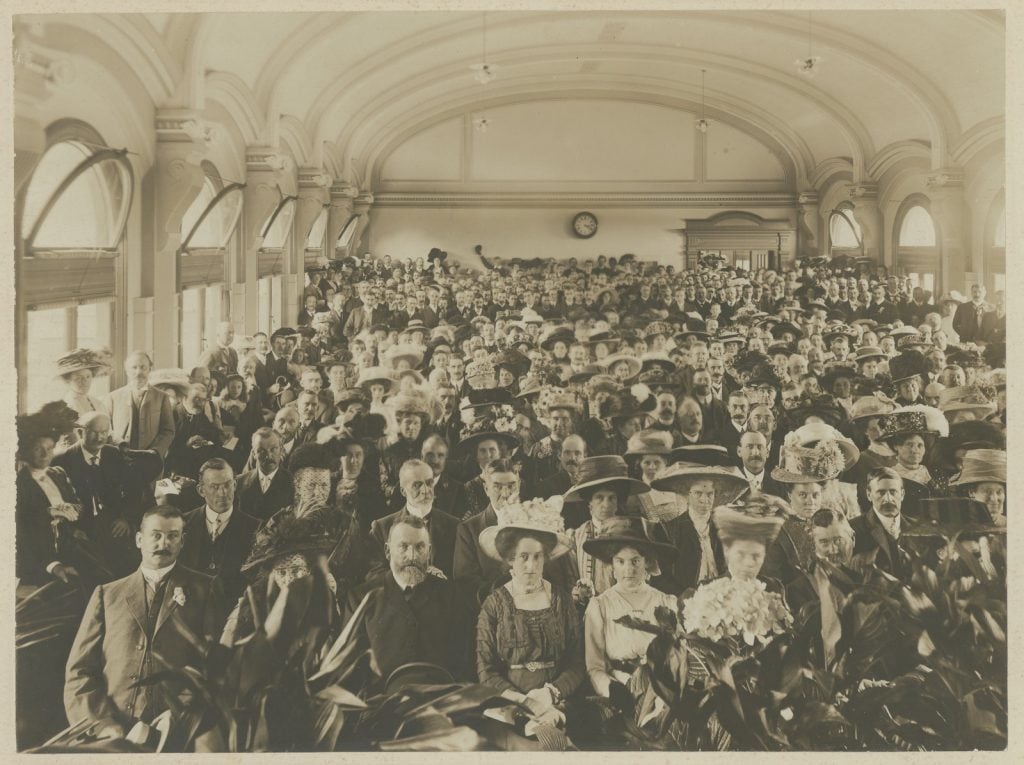
Table Talk magazine spoke glowingly of the new facilities when they opened in January 1910:
‘In the new institute rooms, comprising over a dozen, every comfort and equipment of a modern club has been installed. There is a splendid large concert hall, with ante-rooms, a billiard room, with three of the best tables, a gymnasium, with all- the latest equipment, dressing and bath rooms, games room, reference and lending library (the latter containing not far short” of -10,000 volumes elaborately numbered and indexed), reading and smoking rooms, and class rooms… The rooms are furnished in an ornate and substantial manner, and the walls are decorated with tastefully framed and artistic pictures.’ (Table Talk 27 January 1910, p 10)
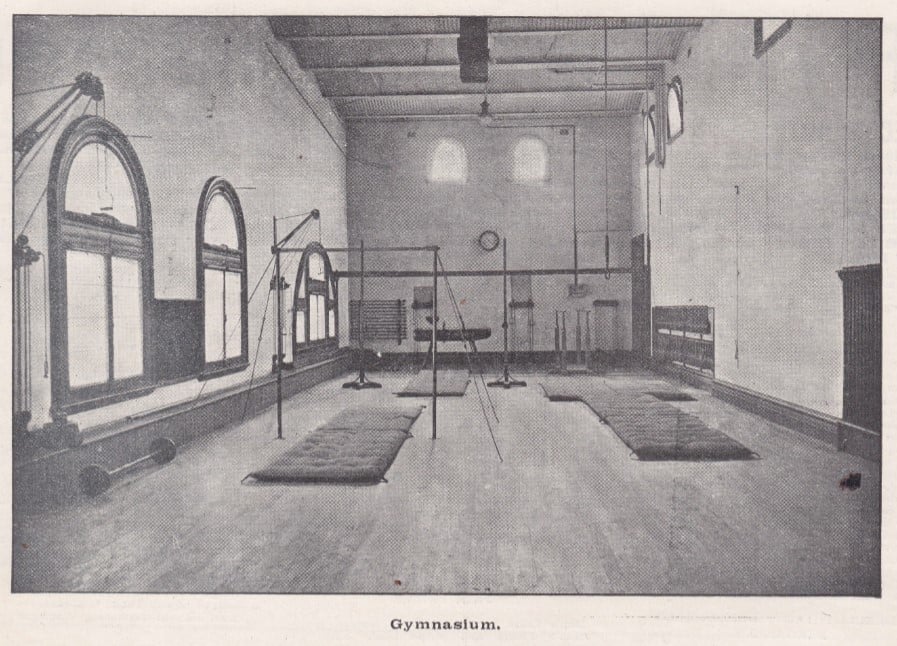
The person responsible for this grand fitout was James Fawcett, an architect, and Railways Department employee, who won a competition to design the station itself, and was later made architect to the VRI. A notable feature of the concert hall was its intricate vaulted pressed metal ceiling. In fact, the Art Nouveau-inspired pressed metal at Flinders Street is considered some of ‘the most diverse and extensive’ in any Australian public building.5
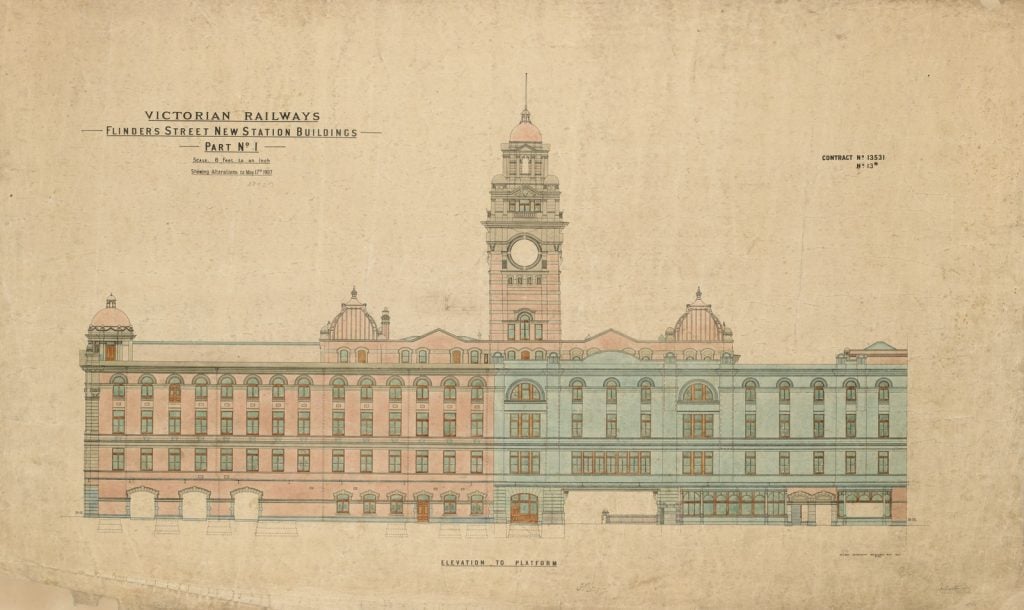
Each month VRI members would receive a newsletter which outlined ‘Amusements at the Institute’. These included an amateur dramatic society; music and orchestral societies; picture entertainments; and classes in gymnastics, physical culture, boxing and wrestling. 6 7 The newsletter also provided updates on new titles added to the VRI’s lending library – if members couldn’t make it to Flinders Street they could have their items sent to them through the rail network. 8
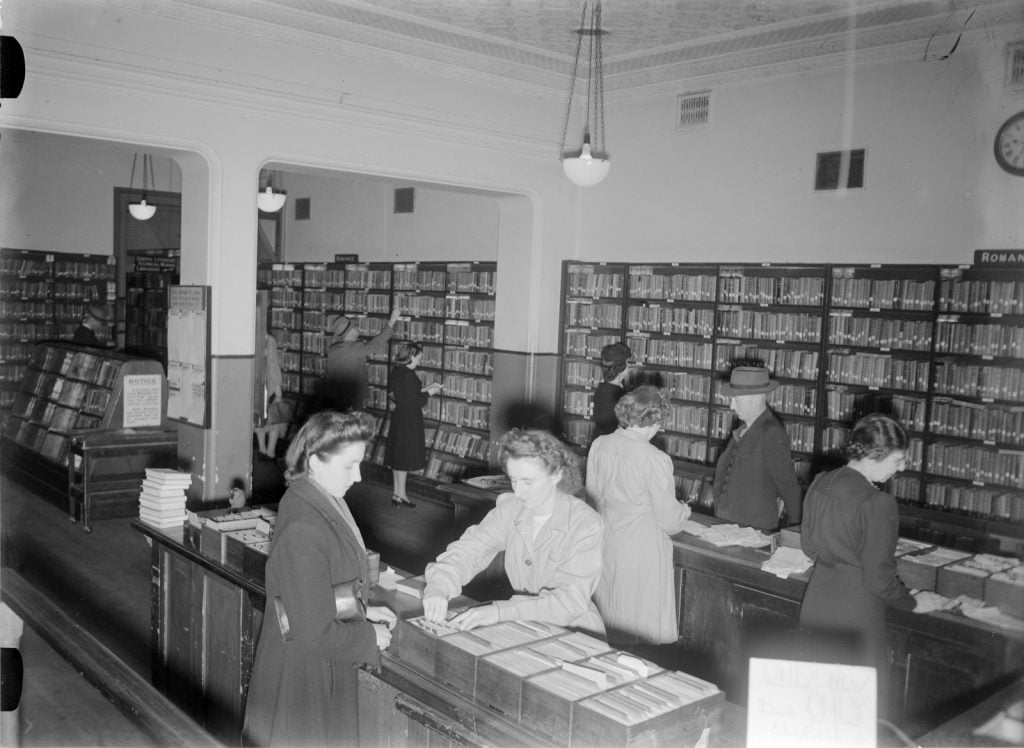
As early as 1918 various clubs were hosting socials and dances at the concert hall. 9 These became increasingly popular, and in 1932-33 the VRI began converting the concert hall to a ballroom, which opened in 1934. By 1935 the ballroom was being extensively used by outside organisations and was a real social hub in the center of Melbourne.10 The conversion to a ballroom saw the removal of the stage to increase room for dancing, and the construction of a boxing ring, for boxing and wrestling displays. When it wasn’t hosting dances, amateur bouts often took place there.11

The 1930s and 40s were the height of social dancing in Melbourne, and the VRI Ballroom was one of the largest dance venues in the city. The two main styles of dance were modern and old time, and the VRI Ballroom ran 50/50 dances, featuring a mix of both styles.12 Compared to other Melbourne venues, the VRI Ballroom attracted a lot of people from the country and had a reputation for hosting real ‘old time’ dances. 13
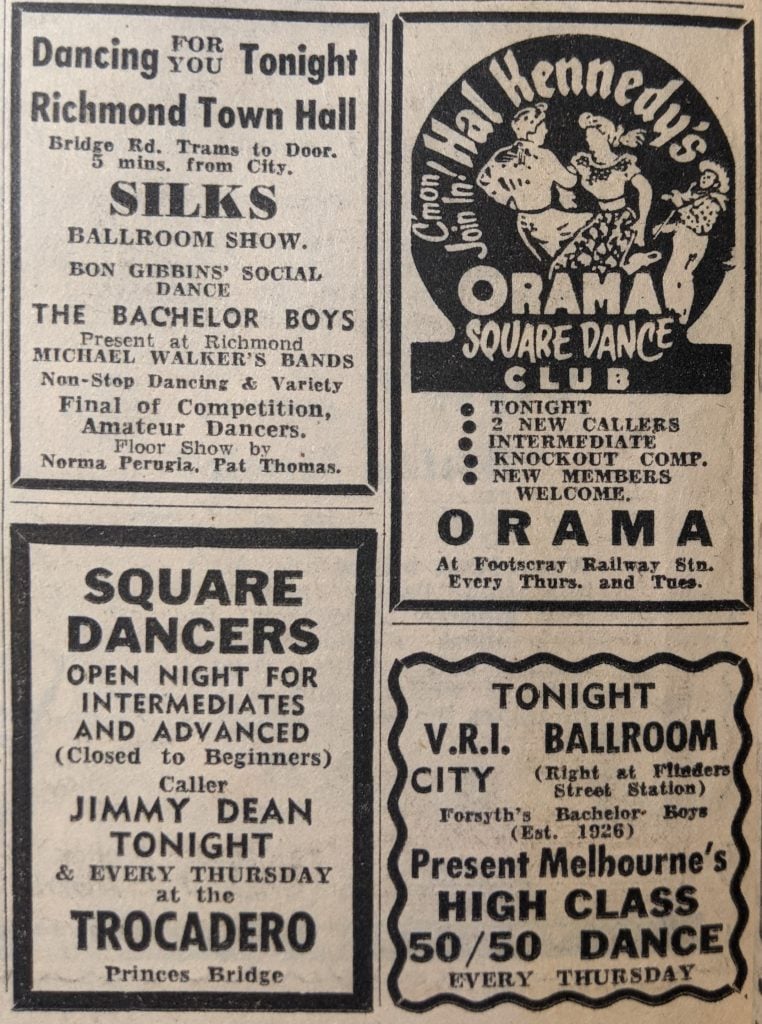
The ballroom was never licensed and only sold soft drinks and snacks, but this didn’t stop some attendees partaking in a sly drink – they would pop out to a nearby establishment before coming back smelling of beer. In contrast to the glamorous image we may have of the ballroom, some found the facilities less than welcoming. Mary Murray, who was a regular, said “the lifts used to be very quiet and the long passageway there used to give me the creeps, especially when you were leaving the dance.” 14
The Ballroom and VRI facilities existed largely without controversy, aside from an unfortunate problem with falling objects. In January 1948 a 150 lb block of masonry fell from the façade of the VRI shortly after peak hour. It tore a hole in the verandah roof on its way down and nearly hit several pedestrians. (The Argus, 7 January 1948, p 1) There are also stories of errant tennis balls, basketballs, and even a medicine ball flying through the open gymnasium windows to the street below. 15
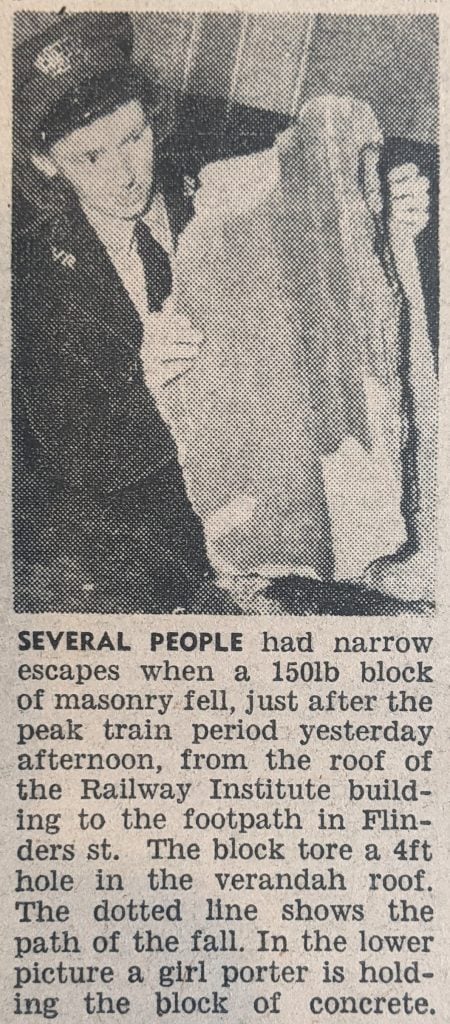
Although still heavily used, by the 1970s the ballroom was no longer hosting the packed schedule of dances it once did. Ron Richards and the Bachelor Boys were still hosting Thursday night dances there, which they had since 1925, but the popularity of rock and roll meant interest in ballroom dancing had declined.16 By this time, the various rooms at VRI were being rented out to an eclectic variety of groups, including ‘the Chihuahua Club, the Cat Protection Society, Australian Matchbox Collectors, Melbourne, St. Kilda and Collingwood Cheer Squads [and the] Victorian Trugo Association…’17
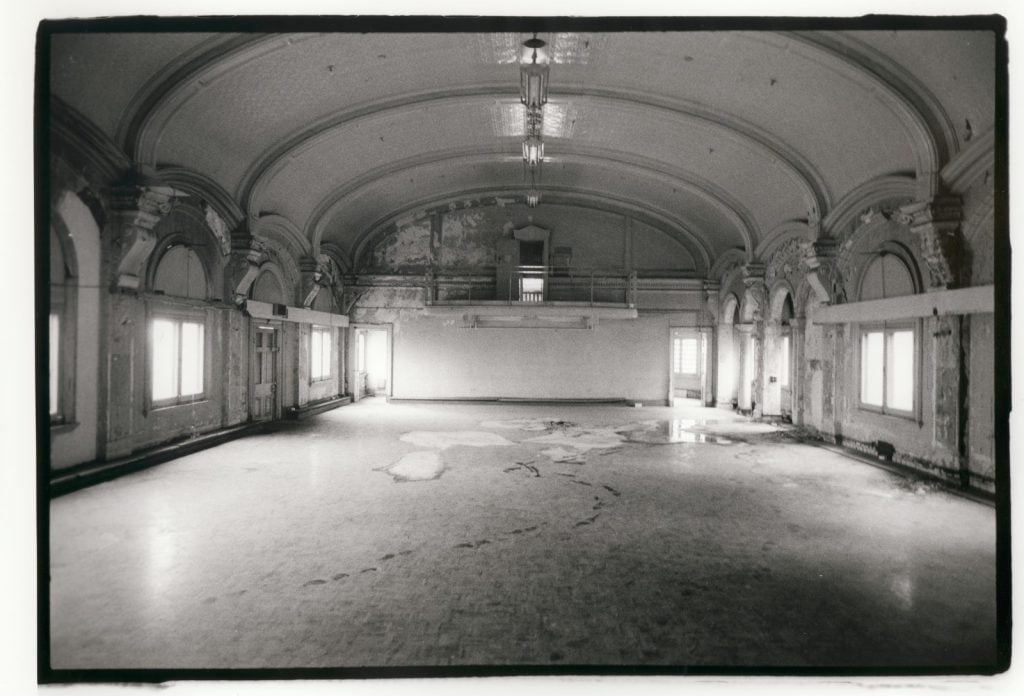
As the 1970s went on, the cost of maintaining and repairing the Ballroom became untenable, and the last dance took place on 10 September 1983. The VRI moved their operations to Flinders Lane in 1985. The facilities were mostly converted to offices in 1995, however the ballroom and gymnasium were left intact, falling into disrepair over the years.18 The roof of the ballroom has been recently restored, and the space has been used sporadically over the years. There was talk of reopening it as an alcohol free entertainment venue and art gallery in 1996,19 and Melbourne Open House has run tours of the ballroom in past festivals.20 Hopefully we will eventually see this once grand space returned to its former glory.
- Hamilton, J, 1972, ‘It all happens at Flinders Street’, The Herald, 3 June, p 23
- Davies, J, 2008, Beyond the façade, J Davies, Mt Macedon, p 59
- Love, P, n.d., Victorian Railways Institute, eMelbourne, viewed 18 May 2021, <https://www.emelbourne.net.au/biogs/EM01561b.htm>
- Davies, J, 2008, Beyond the façade, J Davies, Mt Macedon, p 58
- Allom Lovell & Associates, 1990, Flinders Street Station conservation study: prepared for Flinders Street Festival, Allom Lovell & Associates, Melbourne, p 83
- VRI Review, 1910, no 1, p 24
- Davies, J, 2008, Beyond the façade, J Davies, Mt Macedon, p 87
- See above, p 102
- See above, p 87
- Allom Lovell & Associates, 1990, Flinders Street Station conservation study: prepared for Flinders Street Festival, Allom Lovell & Associates, Melbourne, p 41
- Davies, J, 2008, Beyond the façade, J Davies, Mt Macedon, p 88
- Ritchie, B, 1997, Light on their feet: an oral history of social dancing in Melbourne, 1935 to 1950, B Ritchie, Fitzroy, Vic, p 9
- See above, pp 19-20
- See above, p 20
- Davies, J, 2008, Beyond the façade, J Davies, Mt Macedon, pp 110-111
- See above, p 91
- Hamilton, J, 1972, ‘It all happens at Flinders Street’, The Herald, 3 June, p 23
- Davies, J, 2008, Beyond the façade, J Davies, Mt Macedon, p 93
- Button, V, (12 January 1996) ‘Action station! Premier has a plan’, The Age, p 5, viewed 18 May 2021
- Fowler, M, (12 May 2019), ‘I think the people of Melbourne deserve to have the space back’, The Sunday Age, p 4, viewed 18 May 2021


In the 1980s the Youth Hostels Association ran activities clubs. Once a week the various clubs set up in the VRI ballroom to talk to people about the coming activities. I think it was Monday nights.
I joined the Canoe club.
In the late 1960’s there was a dance every Saturday night. To earn a few extra dollars Mum used to prepare the evening supper … big urns of boiling water, jugs of milk, huge tea pots, cups and saucers and from memory plates of assorted sweet biscuits. As a youngster my sister and I used to watch the adults waltzing, fox-trotting, twirling around the ballroom. Every week we would keep an eye open for one of the regular women – we named her Fishy – she always wore colourful fishnet stockings and a fancy outfit. After supper Mum would hand wash and dry all of the crockery etc… no electric dishwasher back then – we often slept under one of the tables and then Mum would wake us when it was time to go home. Fond memories.
What a fantastic memory – thank you for sharing. I was up in the ballroom to see the Patricia Piccinini exhibition, and you can actually still peak into the kitchen area.
I must get myself in there and have a look! Thank you for letting me know Blair.
Imet myhusband at the dance on Saturday night.in 1965. We were married 56 years yesterday 24th June. It was such a great place to dance with no problems everyone just had fun old time and modern dancing. I loved the Barn dance where everyone got to speak to each other
The most extraordinary exhibition and peak into a remarkable historical building. Definitely an exhibition to see and experience, combined with a walk into history that is memorable. Highly recommended!
Sadly like a lot of Melbourne’s history, been destroyed.
Buildings like these need to be restored and used not replaced with glass and concrete jungles
Hi Feiona,
Thanks for your comment. I very much agree – it would be great to see these spaces restored to their former glory.
Regards,
Blair
So many fascinating details! I love it that the Vic Railway Institute was developed, in all its glory, to help counteract the influence of trade unions – which must have been doing too good a job looking after the interests of their members. Whichever way you look at it, trade unions are a force for social good!
I believe the ballroom is to be open to the public, when is this, the days and time please.
Hi Margot,
It looks like the ballroom is open for the Patricia Piccinini exhibition until 12 June. Have a look at the Rising Festival website for details: https://rising.melbourne/festival-program/patricia-piccinini
Regards,
Blair
What is the function advertised for , I think , this Thursday2/10/22 in the VRI ballroom or is it the Exhibition building and cupola.
A friend, Carol who now lives in Bundaburg Q met her husband in the VRI . A tobacco farmer in the Myrtleford area, Peter was encouraged to go to the VRI in the 1960s to find a bride .
Another connection was cabinetmaker/ wood sculptor named Frederick Stenning made a table that was used and displayed in the VRI ? Thanks
.
Hi Jill,
Thanks for sharing the story of your friend and her husband, and the connection with cabinetmaker Frederick Stenning.
I believe there is a new exhibition opening in the VRI ballroom on 28 Oct: https://rone.art/ – this might be the one you are referring to? It’s fantastic that the spaces are continuing to be used.
Regards,
Blair
My father George Peters used to be a doorman at the Thursday night VRI ballroom dance in the late 1960’s, 1970’s up until the early 1980’s.
He also prepared the dance floor for the dancers so that they could glide over the floor by adding a special powder/wax mix to get rid of any sticky spots. Getting the dance floor to be the right balance was a real art and if it was too fast (slippery) he would slow it down by spreading another mix.
Another regular doorman was the famous Ted Rippon who was an ex-Essendon footballer in the 1930’s, publican & policeman.
You had to take a lift up to the 3rd floor VRI ballroom & my father told me that in the past that the lift down was not always a safe place if you were being ejected from the dance for a misdemeanour.
Ron Richards was the leader of the “Ron Richards Rhythm Kings” ballroom dance band & I believe he continued playing into his late 80’s.
As a 14-15 year old teenager in the late 1960’s I worked serving drinks (cordial, tea & coffee) & biscuits for the dancers during their dance breaks.
Regards,
Ian
Thanks so much for sharing these memories with us Ian. It’s great that this post has inspired people to share their personal experiences of visiting the VRI ballroom. I love the story of your father waxing the dance floor. And how wonderful that you got to work there as a teenager.